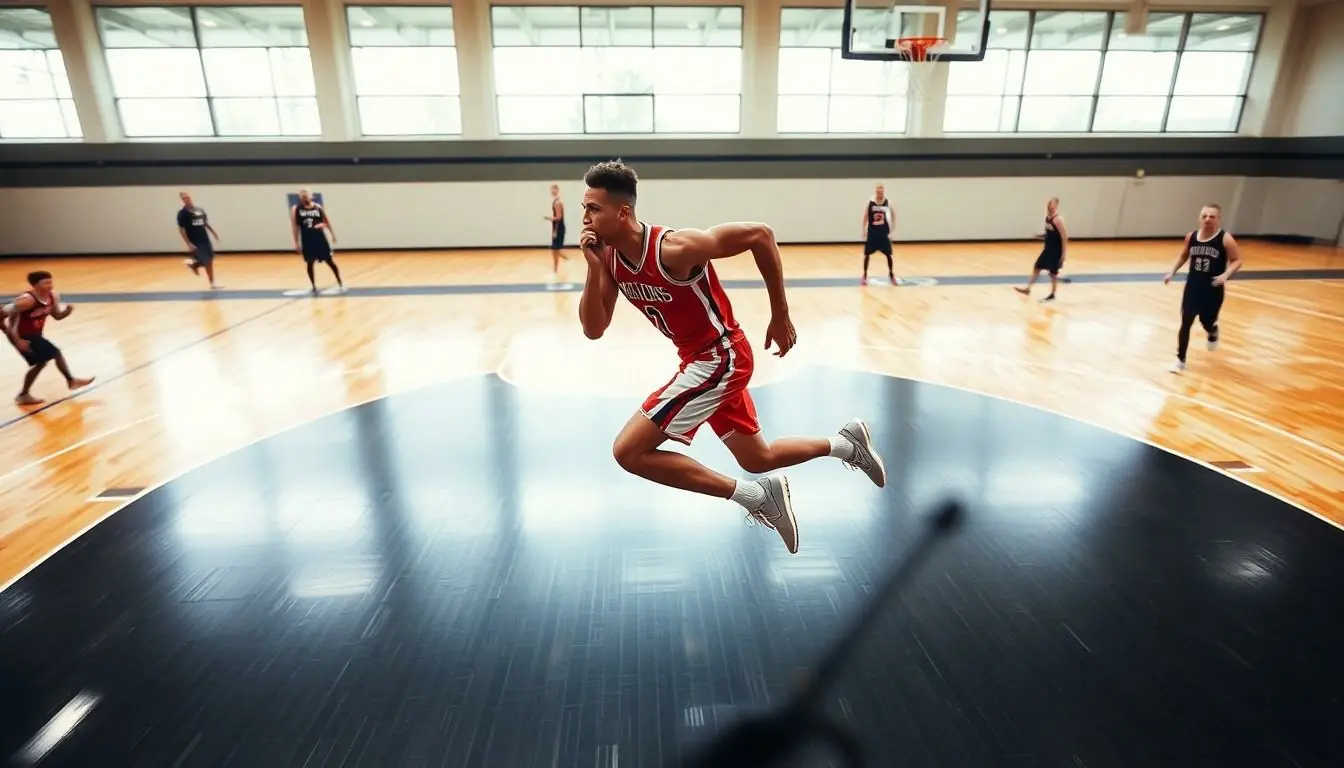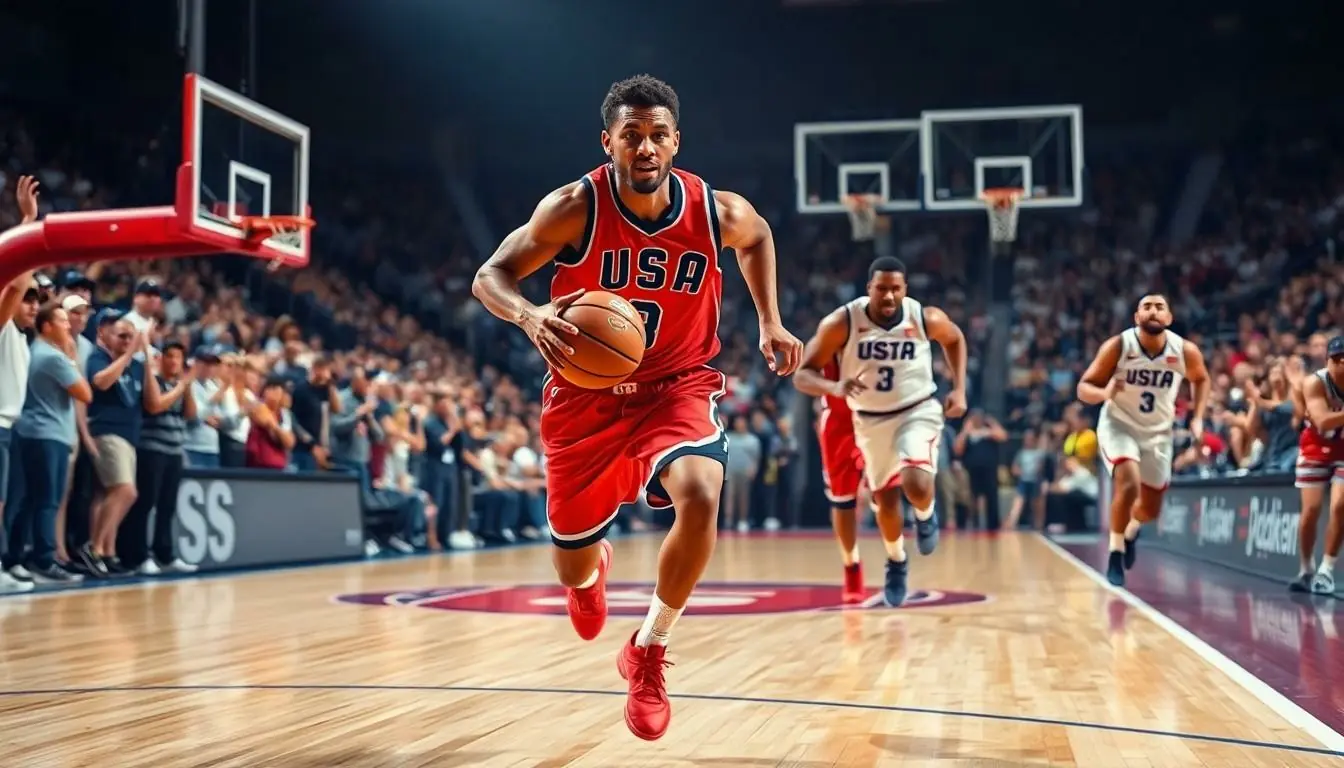Fastbreak basketball isn’t just a style of play; it’s a thrilling race against time that leaves fans on the edge of their seats. Picture this: a team snatches the rebound, and in the blink of an eye, they’re sprinting down the court. The ball zips from player to player like a hot potato, and before the defense can even catch their breath, the offense is scoring. It’s chaos, it’s excitement, and it’s the kind of heart-pounding action that makes basketball worth watching.
Table of Contents
ToggleOverview of Fastbreak Basketball
Fastbreak basketball showcases a fast-paced style of play that elevates the excitement of the game. This strategy emphasizes quick transitions from defense to offense, pushing players to react instantly and decisively. Teams often capitalize on opportunities arising from defensive rebounds or turnovers, launching immediate attacks while the opposing defense remains unsettled.
Players work in unison, moving the ball rapidly up the court. Each second counts, as players aim to score before defenders can recover. Key elements of successful fastbreaks include precise passing, sharp shooting, and strategic positioning. Athletes must excel at reading the game, knowing when to push and when to pull back.
Statistics reveal that fastbreak points are a critical aspect of scoring efficiency. In the 2022 NBA season, fastbreak points accounted for approximately 12.5% of total points scored, emphasizing its importance in modern basketball. High-energy teams often dominate in this area, forcing opponents to adapt their defensive strategies.
Coaching plays a significant role in implementing fastbreak tactics effectively. Coaches design plays that maximize pace and utilize players’ strengths. Practicing these strategies equips teams to execute them seamlessly during games, creating thrilling moments that energize fans.
Athletes gain an advantage when they prioritize conditioning and teamwork. Superior physical fitness helps maintain speed and endurance throughout the game. Synergy among teammates also fosters better communication, ensuring that everyone knows their role in fastbreak situations.
Overall, fastbreak basketball exemplifies the dynamic nature of the sport, engaging spectators and pushing teams to innovate their gameplay continuously.
Key Principles of Fastbreak Basketball

Fastbreak basketball relies on a few core principles that shape its exciting gameplay. These principles include speed, timing, space, and angles.
Speed and Timing
Speed serves as a critical factor in fastbreak basketball. Teams push the ball up the court immediately after a rebound or turnover, maximizing opportunities for quick scoring. Players must sprint down the court to outpace the defense. Timing plays a vital role, too; the perfect moment to pass or shoot can lead to easy baskets. Players who excel at timing create open looks, capitalizing on the opposing team’s disorganization. Practicing quick transitions fosters better speed and enhances on-court chemistry among teammates, amplifying scoring chances during fastbreak situations.
Space and Angles
Space management significantly impacts the success of fastbreaks. Players must spread out on the court to create passing lanes and prevent defenders from collapsing on the ball handler. Utilizing angles effectively allows players to take advantageous paths toward the basket. Open lanes and sharp angles open up scoring opportunities. Players should anticipate defensive movements and adjust their positioning accordingly. Optimizing space and angles creates a dynamic flow on offense, keeping defenders guessing. Teams that master these principles can execute fastbreaks more efficiently, leading to higher scoring potential.
Strategies for Effective Fastbreak Basketball
Fastbreak basketball requires a strategic approach to maximize scoring opportunities during swift transitions. Teams that implement effective strategies can leverage their speed and coordination to outmaneuver opponents.
Transition Offense
Transition offense plays a crucial role in fastbreak execution. Players need to recognize the moment a defensive rebound occurs or when a turnover happens, prompting immediate action. Pushing the ball up the court occurs without delay, creating open shots before the defense has time to set up. Teams often rely on quick, accurate passing to maintain momentum. Furthermore, effective transition offense generates high-percentage scoring opportunities in the paint or from beyond the arc.
Player Roles and Responsibilities
Defining player roles significantly influences fastbreak efficiency. Point guards typically take on the responsibility of initiating the fastbreak, driving the ball up the court rapidly. Wings support by sprinting to designated spots to provide passing options. Forwards often trail the play, ready to finish strong around the basket. Communication among players remains essential to ensure alignment during fastbreak situations. Recognizing each other’s positions allows teams to exploit defensive weaknesses effectively, leading to successful scoring plays.
Common Mistakes in Fastbreak Basketball
Fastbreak basketball involves quick transitions, and mistakes can undermine scoring opportunities. Here are some common mistakes players should avoid.
Poor Decision Making
Too often, players make hasty or ill-informed decisions during fastbreak situations. Rushing a shot can lead to poor shot selection, reducing scoring chances. Players must evaluate their options quickly while considering the defense’s positioning. A lack of awareness risks missing open teammates, which can result in lost opportunities. Limited passing can stall momentum, allowing the defense to recover. Players must recognize when to drive for a layup or kick out for an open three-pointer. Successful fastbreaks occur when players make intelligent choices that capitalize on defensive breakdowns.
Lack of Communication
Effective communication is vital during fastbreaks. When players don’t verbally communicate their intentions, confusion often arises. One player may assume another will cut to the basket while that player remains stationary. Encouraging clear cues, such as calling for the ball, significantly improves coordination. Additionally, teams should establish non-verbal signals to maintain fluidity and reduce misunderstandings. Players often overlook the importance of recognizing their teammates’ movements. Consistent communication fosters trust and enhances the likelihood of successful scoring opportunities.
Fastbreak basketball embodies the essence of excitement and strategy in the sport. Its rapid pace not only thrills fans but also challenges players to perform at their best. By mastering the principles of speed timing and space teams can maximize their scoring potential while keeping opponents on their toes.
Effective communication and strategic execution are vital for success in fastbreak situations. As teams continue to innovate and adapt their tactics the impact of fastbreaks on the game will only grow. Embracing this dynamic style of play can lead to unforgettable moments on the court and elevate the overall basketball experience for players and fans alike.




